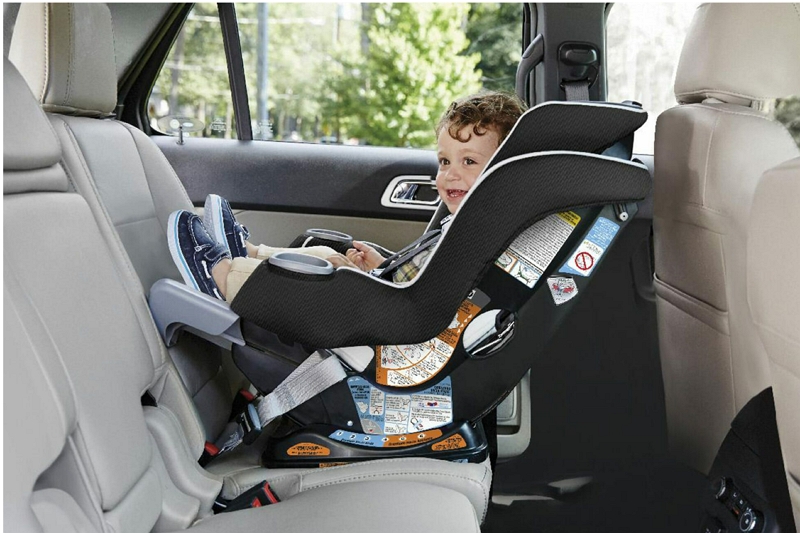In this guide, you will learn How to install rear facing car seat with seatbelt. The steps are easy and simple.

Methods of Installing Rear Facing Car Seat with Seatbelt
#1 – Using a LATCH system. Make sure to use the lower Anchors provided with your car seat and also make sure they are tightly fastened before moving on to step two.
#2 – Lap belt installation, which uses just one anchor for simplicity sake.
To do this you will have loosened up the buckle of the Lap/shoulder belt that attaches to the middle of your backseat or towards the bottom of the rear door frame where it meets the floorboard then pull out excess slack so there’s enough room for the baby girl’s head in between seats when she grows older without being too tight, threading through metal loops at either side closest to vehicle doors until both ends meet together again with a clap.
Can my 1-year-old sit in a front-facing car seat?
Your child should remain rear-facing until at least age two or they have outgrown the height and weight limits of their car seat.
Your paediatrician will advise you if your one year old can safely ride in a front-facing car seat. Generally, children who are not yet developmentally ready to sit up without support can’t be placed forward-facing as it is dangerous for their body and brain to experience such high G forces during sudden stops or accidents.
Some kids may also need more time because they cannot control their head movements well enough so that it doesn’t flop around dangerously when going over bumps and turning corners. Front-facing seats offer much better protection than older style convertible models by distributing crash impact force across the strongest parts of the body.
Parents may also want to consider using a convertible seat with your very young children if they are struggling with their neck strength since the harness straps need to be raised into position each time you switch between rear and forward-facing modes, which can take some practice for tiny babies who have limited mobility.
They will likely appreciate this feature more once they get older as well because it means less work for them when putting on their car-seat belt every day!
Some parents find that purchasing an inexpensive infant carrier or babywearing device is much easier than lugging around a heavy convertible car seat until their child outgrows the weight limits of his/her infant model. If you do decide on getting another larger model before over, make sure that your little one has enough neck strength and head control to hold it up on their own.
The key is that your child should not be less than one year old, under the height or weight requirements for a forward-facing car seat, and able to sit up without support to use this type of product. Talk with your paediatrician if you have any questions about using a front-facing model before turning two years old because every kid develops at his/her own pace!
How much should a baby weigh to face forward in 2021?
By 2021, it’s expected that babies will weigh significantly more than they did in 2011. For women with a BMI of 25-29 to face forward in the car seat for their child during an accident, their baby should weigh at least 11 pounds.
Women who are overweight would need their baby to be even heavier so this is something parents may want to factor in when making plans about how much their children will weigh by 2021.
This seems like good news because it means that fewer obese people are being born into our world but bad news since obesity can lead to other health concerns which could affect young lives.
It’s important not only to look at numbers when thinking about planning your pregnancy, though; you also have to take into account whether or not mothers are attempting to lose weight or if they are planning on breastfeeding. These factors could lower the number of pounds needed for a baby by 2021.
Can a 10-month-old use a forward-facing car seat?
The American Academy of Pediatrics (AAP) recommends that all children under the age of two rides in a rear-facing car seat. This is because it has been shown to reduce their risk for injury by almost 90% when compared with riding facing forward. Unfortunately, this can make your trips feel like they take much longer than usual and may even delay you getting where you need to be on time.
The good news is that many convertible seats have higher weight limits so that older babies and toddlers can stay rear-facing until around age two or beyond! If at all possible, we recommend keeping your little one in a rear-facing car safety seat as long as possible before transitioning them into a front-facing model – just keep them there until they reach the weight limit of their seat.
How long should a baby be rear facing in a car seat?
The American Academy of Pediatrics (AAP) recommends that babies should be kept rear-facing until they outgrow the height and weight limits for their seat. This usually occurs at around age two but can vary by brand. Many parents purchase a convertible car seat because it will last longer than an infant specific one which only lasts up to 25 pounds.
